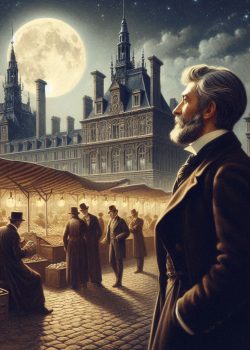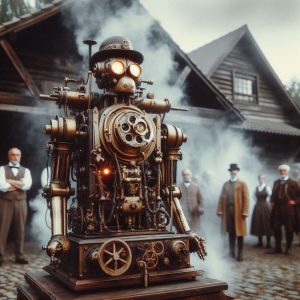
(Previous)…..(Content)…..(Next)
The 19th Century, the birth of true “SF”
The years of Shelley, Poe, Litton, Wells, and “father” Verne
(Romanian)
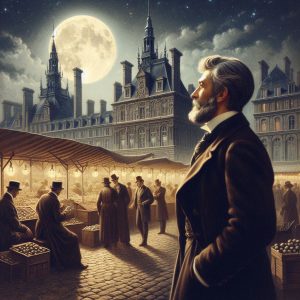
The chronological description of the evolution of “Science Fiction” reached the 19th century…
A period of great social and technological transformations, that had a significant impact on literature, during this period the first novels that can be considered true works of “Science Fiction” appeared (which laid the foundations for the later development of the genre), exploring themes such as space travel, advanced technologies, and utopian or dystopian societies.
Obviously, from what I described above, it cannot be said that these steps could be considered to be something innovative.
But, if we take into account the fact that the first “scientific” elements appeared (related to the knowledge of those times), we cannot help but notice that the transition was made from what would be “Fiction” with the particularization of “Fantasy”, to “Science Fiction”…
This century, which, contrary to expectations, is a very active century (with many fantasy and SF-F “titles”) and representative of “Science Fiction” (you will see in the following), “starts” with two novels (somewhat more “important”): Jean-Baptiste Cousin de Grainville publishes The Last Man (1805) and E. T. A. Hoffmann publishes The Automaton (Die Automate – 1814).
In detail, “The Last Man” (Le Dernier Homme) (a novel published posthumously in 1805) is a notable work, often considered one of the first apocalyptic novels in French literature and even a precursor to end-of-the-world science fiction (being considered an early apocalyptic novel, combining fantastic elements and a prophetic vision of the extinction of humanity, some also classifying it as an early form of science fantasy or dying earth).
The novel explores the theme of the end of humanity, drawing inspiration from the Book of Revelation, taking place in the year 2000 (a futuristic perspective for the time), following the last two humans on Earth: Omégarus (the last Adam) and Syderia (the last Eve). God sends a female messiah to try to save the world, but Omégarus, at the urging of Adam (who is kept alive until the end of the world), abandons Syderia, the novel “recording” the progressive destruction of the Earth and the despair of the last humans.
It is written in a poetic and epic style, influenced by John Milton’s Paradise Lost, and is believed to have influenced other works with similar themes, including Mary Shelley’s later published novel of the same title.
Returning to the short story “Die Automate“, originally published in the literary-cultural journal Zeitung für die elegante Welt and then included in his collection Die Serapionsbrüder in 1819, the narrative presents a series of interconnected episodes shared during a gathering of men exploring supernatural and philosophical themes, a central element being the discussion of a swinging golden ring and whether its movement is controlled by the collective will, although it does not focus exclusively on a single automaton, the story including elements relevant to the theme of automatons and the relationship between man and machine, which was a frequent concern in Hoffmann’s work.
A significant segment of “Die Automate” includes the story “Der sprechende Hund” (“The Talking Dog”), which explores the idea of unusual intelligence and unexpected capabilities, also mentioning a famous automaton, “The Talking Turk”.
It is noteworthy that it is a relevant work for understanding Hoffmann’s fascination with themes related to automatism and the perception of reality, which is most famously manifested in the story “Der Sandmann” (“The Sandman”), a short story originally published in 1816, in the first part of the story collection Nachtstücke (“Night Pieces”), being one of Hoffmann’s most famous and influential works, a complex exploration of themes related to reality versus illusion, madness, anxiety about automatons, and the destructive power of childhood trauma.
The story is presented in an “episodic pattern”, through a series of initial letters, followed by the main narrative. The young student Nathanael writes to his friend Lothar about the return of a man named Coppelius, whom Nathanael associates with the terrifying figure of the Sandman from his childhood stories (a mythical creature said to throw sand into the eyes of children who will not sleep, causing their eyes to pop out, and to feed it to his chicks on the Moon). Nathanael recalls a terrifying night from his childhood when Coppelius, a repulsive alchemist who worked with his father, was caught during their nocturnal experiments, and Nathanael’s father died in a mysterious explosion (believing that Coppelius was the Sandman and blaming him for his father’s death).
Nathanael moves to the university and falls in love with Olimpia, the quiet and beautiful daughter of his physics professor, Spalanzani, and is completely obsessed with her, ignoring the affection of his fiancée, Clara, and her brother, Lothar. During a party given by Spalanzani, the other guests find Olimpia strange and lifeless, but Nathanael is blinded by her beauty.
Nathanael buys a pocket telescope from a street vendor named Giuseppe Coppola (whom he suspects is Coppelius in disguise), and through it, Olympia appears even more alive and captivating. But in a terrifying scene, Nathanael discovers that Olympia is an automaton, a soulless mechanical doll created by Spalanzani and Coppola, who will fight over Olympia’s dismembered body, and the doll’s glass eyes stare at Nathanael, driving him mad.
Finally, Nathanael throws himself off the tower and dies. Coppola disappears into the crowd. The short epilogue mentions that Clara is living happily with her husband and their children, suggesting a return to normality after Nathanael’s tragedy.

Thus, the story constantly explores the fragile boundary between what is real and what is imaginary or illusory, especially through Nathanael’s obsession with Olympia, highlighting anxiety towards automatons (Uncanny – The figure of Olympia, an automaton that perfectly imitates life, arouses a feeling of unease and strangeness, identifiable with what would be the concept of Unheimlich analyzed by Freud in his essay on this story).
And there would be many more details about “Der Sandmann”, a complex and dark story that had a significant influence on Gothic literature, psychology (especially on Freud’s concept of the uncanny), and even art (inspiring the ballet “Coppélia” and the opera “The Tales of Hoffmann”).
The basic idea was just to emphasize that science was beginning to manifest itself more and more prominently in the written fiction of those times and the “great subjects” of any nature (so not only “Science fiction”) belong to a kind of “surprising” detachment from an already evolutionary wave, many of the great masterpieces being lost to the public in favor of some much less valuable, but “with a current audience” (a kind of “pre-modern” social network).
From here (in 1818), we can notice a “first connection” that became famous, between Gothic and science, which can be achieved through various authors of those times, but the “start” comes, without a doubt, with the novel “Frankenstein“, written by Mary Shelley, considered to be a masterpiece of Gothic literature and a precursor of science fiction…
But, this novel also has another “background”, less known to current readers… Which confirms the increasingly “efficient” insertion of science into fiction…
In the previous episode, we described some of the trends in writers describing automatons in various forms. Right?
Well, the late 18th and early 19th centuries stand out as a period when experiments with electricity on human corpses (possibly “spare parts” for Frankenstein) gained significant attention and captured the public’s imagination.
Here’s why this period is relevant to my statement:
Luigi Galvani’s experiments (late 1780s–1790s): Italian physician and physicist Luigi Galvani conducted experiments on dissected frogs, observing that their leg muscles contracted when electrically stimulated. He theorized the existence of “animal electricity,” a vital force inherent in living tissues. His 1791 publication, De viribus electricitatis in motu musculari (“On the Power of Electricity in Muscular Motion”), sparked considerable scientific debate.
Alessandro Volta’s answer (around 1800): Alessandro Volta, another Italian physicist, disagreed with Galvani’s concept of “animal electricity.” He argued that electricity was generated by the contact of dissimilar metals and that animal tissue only reacted to this external current. This led to his invention of the voltaic pile, the first true electric battery, around 1800.
Giovanni Aldini’s Demonstrations (early 1800s): Giovanni Aldini, Galvani’s nephew, took these experiments further, performing public demonstrations throughout Europe, including on the human cadavers of recently executed criminals. He used voltaic piles to apply electric currents to the bodies, causing dramatic muscle contractions, facial grimaces, and even the opening of an eye (One of his most sensational demonstrations took place in London in 1803 on the body of George Forster, a convicted murderer. Witnesses were reportedly shocked, and some even believed they were seeing the dead rise to life, an event widely publicized with the “possibilities” of the time).
Influence on literature: These real-life experiments with electricity and cadavers are widely considered a significant source of inspiration for Mary Shelley’s novel “Frankenstein, or the Modern Prometheus” (in addition to the “sources” already presented) which explores themes of life, death, and the potential dangers of scientific ambition (the mad scientist had appeared in much earlier novels), fueled by the contemporary fascination with galvanism and the possibility of reanimating dead tissue with electricity.
So, Frankenstein or the Modern Prometheus explores themes that have remained relevant throughout the centuries, following the story of Victor Frankenstein, a young scientist obsessed with the idea of creating life.
Through a series of scientific experiments, he manages to bring a monstrous creature to life, but is horrified by the result of his work and abandons it, the “Monster” is rejected by society and his creator, embarking on a path of loneliness and revenge.
Frankenstein’s monster is a complex figure, often presented as a victim of society, but also as a destructive force, especially after isolation and rejection by society, emphasizing the importance of human connections.
Thus, the novel explores deep themes such as creation, responsibility, identity, isolation, and the consequences of science, becoming a warning about the danger of manipulating the forces of nature without fully understanding the consequences.
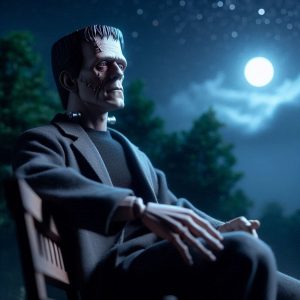
“Frankenstein” has spawned countless cinematic, literary, and artistic adaptations, becoming an iconic symbol of human ambition that transcends the boundaries of ethics, anticipating many of the themes that would be explored in this genre, such as bioengineering, artificial intelligence, and scientific ethics.
Additionally, it can be interpreted as an allegory of the Industrial Revolution and fears related to scientific progress.
Anyway, we only “discussed” a brief intersection between Gothic and “science fiction”, the Gothic genre having its own different “path”, difficult to fit even into the “Fantasy” subgenre, which will “culminate” with Dracula, Bram Stoker’s novel, published in 1897, considered to be an emblematic work of the Gothic genre (and a point of reference for noticing the difference between genres).
Should I also mention that Mary Shelley also published a work, The Last Man (1826)? A novel considered to be remarkable and often one of the first apocalyptic and dystopian novels in English literature, a significant precursor to end-of-the-world science fiction.
A novel that has an unusual narrative framework, where Shelley introduces a fictional preface in which she claims to have discovered in 1818, in a cave near the city of Naples, prophetic writings painted on leaves by the Sibyl of Cumae. Stating that she edited these writings in the narrative of a man living at the end of the 21st century, starting with the year 2073 and ending in 2100, presented as an ancient prophecy. Where a Europe is ravaged by a terrible plague that quickly spreads across the globe, ultimately leading to the almost complete extinction of humanity (the novel is narrated by Lionel Verney, who comes to believe that he is the last man on Earth, recounting the events that led to the global disaster, including political conflicts, wars and, ultimately, the implacable triumph of the epidemic) (???).
Exploring how quickly and completely society can collapse in the face of unexpected catastrophe, Shelley examines people’s reactions to fear, despair, loss, and isolation (Lionel’s experience as the last man standing is a profound meditation on absolute loneliness)…
Should I also point out, in my cynical “know-it-all” style, that the characters in the novel are believed to be partly inspired by Shelley’s romantic circle, particularly her husband, Percy Bysshe Shelley, and Lord Byron?
Continuing the series of “correlations”, there would be the case of the novel The Mummy! A Tale of the Twenty-Second Century, written by Jane Webb Loudon (who was only around 20 years old at the time of publication), published anonymously (in three volumes) in 1827… A notable novel and often considered one of the first works of science fiction in English literature (pioneering) that explores a distant future and introduces unusual concepts for its time, mixing Gothic, satirical and futuristic elements, presenting a reanimated mummy (even if it is believed to have been influenced by Mary Shelley’s “Frankenstein”).
Set in the year 2126, the film offers a vision of the distant future from the perspective of the 1820s, following Edric Montagu, an ambitious young man who, along with an eccentric scientist, undertakes an expedition to Egypt to reanimate the mummy of Cheops (Khufu) using galvanic electricity. Once brought back to life, Cheops integrates into 22nd-century English society and offers unique insights into politics, religion, and philosophy.
The novel depicts a futuristic England with advanced technologies for the author’s time, including air travel by rubber balloons, steam-powered automatons for various professions, including surgeons and lawyers, an early form of the internet or communications network, mobile homes on rails, etc.
And such developments will be encountered at any moment of the passage of time along with “Science Fiction”…
So, “Science Fiction” evolved, with writers like Edgar Allan Poe standing out… Who, around the mid-19th century, reflected the rather “sci-fi” trends of the times.
Although Edgar Allan Poe is best known for his Gothic and horror stories, his work had a significant impact on the development of science fiction, with many of the themes and motifs addressed by Poe anticipating the central concerns of the science fiction genre.
Poe was fascinated by the unknown, by the mysteries of nature and the human psyche, a curiosity that led him to explore themes such as outer space, the depths of the ocean, and the world of dreams, which are central themes in science fiction, exploring the potential of technology to alter reality and create surreal experiences.
Poe’s characters are often marked by obsessions, phobias, and mental disorders, which anticipates the interest in psychology and artificial intelligence in modern science fiction, many of Poe’s stories create an atmosphere of suspense and mystery, exploring themes such as death, madness, and the human condition, a dark atmosphere that influenced generations of science fiction writers, who explored similar themes.
Examples of Poe’s stories that anticipate science fiction would be:
- “The Narrative of Arthur Gordon Pym of Nantucket” (1838), is a seafaring adventure story that explores themes such as isolation, survival, and the discovery of new worlds.
- “The Descent into the Maelström” (1841), is a story that describes a sailor’s descent into a whirlpool, exploring the fear of the depths and the power of nature.
- “The Pit and the Pendulum” (1842), this story describes the torture of a prisoner in a Spanish prison, combining elements of horror and suspense.
- “The Masque of the Red Death” (1842), this story presents a mysterious and macabre epidemic in an isolated castle, exploring themes related to death and decadence, or
- “The Tell-Tale Heart” (1843), explores themes of guilt, paranoia, and madness and is often associated with the psychological horror genre.
Thus, according to “critics”, many science fiction writers, such as Jules Verne and H.G. Wells, were influenced by Poe’s work.
Although, in addition to the works already mentioned, some can be assimilated to the “Verne Period”, when he “was a child” or when he evolved together with the authors and works:
- Rappaccin’s Daughter by Nathaniel Hawthorne (1844), a complex and disturbing short Gothic novella that explores deep ethical and psychological themes related to science and nature (the story raising profound questions about the limits of science and the moral responsibility of scientists), has significant resonances with modern science fiction, particularly the subgenres of bio-horror (toxicity being one of the central themes of bio-horror) and early gothic science fiction.
- The Bell Tower by Herman Melville (known primarily for novels such as Moby Dick) (1855), a short Gothic novella (later included in his collection The Piazza Tales, 1856), explores Gothic themes and can be interpreted in the context of proto-science fiction through the fascination with creation, ambition, and the unforeseen consequences of innovation (the protagonist, Bannadonna, creates a complex automaton, a precursor to the concept of the android or artificial intelligence, fueling the motif of the creator destroyed by his creation that is already a classic trope of science fiction).
- The Diamond Lens by Fitz James O’Brien (1858), considered one of the first significant works to combine elements of science fiction with fantasy (romantic) and the Gothic (the story focusing on Linley, a young man obsessed with the microscopic world since childhood, who neglects his studies and responsibilities to perfect his microscope, dreaming of discovering the hidden secrets of nature at the atomic level, claiming that he can communicate with the spirit of Antonie van Leeuwenhoek, the pioneer of microscopy, and thus discovering in a drop of water, an amazing microscopic world, populated by fantastic landscapes and, ultimately, by a single female being of incomparable beauty, whom he calls Animula, etc.),
- Air Battle: A Vision of the Future by Hermann Lang (1859), a significant work in the early history of (pioneering) military science fiction and air warfare fiction (it imagines a near future in which war is fought in the air through flying machines, Lang describing with some technical accuracy for the time these aircraft, which are propelled by engines and equipped with weapons, describing in detail the tactics of aerial combat, aircraft maneuvers, the use of weapons and the impact of this new mode of warfare on global conflict, anticipating the crucial role that aviation would play in future conflicts),
- The Steam Man of the Prairies by Edward S. Ellis (1868), is an early and fascinating work that falls into the subgenre of young adult science fiction and can be considered a precursor to steampunk and the invention novel (it features an amazing invention, a giant, steam-powered mechanical man designed to travel across the American prairies, providing protection from wild dangers and facilitating exploration, created by a young sixteen-year-old inventor named Johnny Brainerd), combining elements of Wild West fiction (Indians, prairie, hunters) with a fantastic technological invention (a kind of more primitive “Wild, Wild, West“),
- Battle of Dorking by George T. Chesney (1871) (speculative military fiction and an early example of future war fiction, dealing with a surprise invasion of England by a foreign power, the narrative being retrospective, told by an old man who remembers the catastrophic events that led to England’s defeat),
- Erewhon by Samuel Butler (1872), a utopia (or dystopia, depending on the interpretation) that contains an early and notable exploration of the idea that machines could become a threat to humanity, a theme that resonates with modern concerns about artificial intelligence (George Orwell acknowledged Butler’s influence via the section “The Book of Machines”, where an Erewhonian philosopher argues that machines are an evolving life form, which constitutes a critique of uncontrolled progress and the potential for human creations to dominate it).
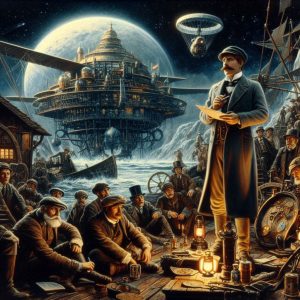
And so we come to Jules Gabriel Verne, rightly considered the father of modern science fiction, who fascinated readers with his adventure novels, in which science and imagination combine in a captivating way.
Especially for those times, when, for a “neutral” observer, it was impossible not to notice that almost every one of his works (over 60 novels and many other short stories) had some kind of scientific foundations, well documented and, above all, well “designed” imaginatively…
But, in terms of the “foundations of science fiction”, Jules Verne stands out for:
- “Journey to the Center of the Earth” (1864): A subterranean adventure that explores the Earth’s interior and anticipates the hard science fiction subgenre.
- “From the Earth to the Moon” (1865) and “Around the Moon” (1869) or “Hector Servadac” (1877): Describe in detail a journey to the Moon, with the help of a giant projectile (or a fragment of earth “projected” by a comet), anticipating future space explorations.
- “20,000 Leagues Under the Sea” (1870): An underwater adventure in a submarine, exploring the depths of the ocean and the marine world.
In the mentioned works, in addition to the remarkable “plot” of any Jules Verne novel, in terms of “Science Fiction”, the anticipation of the future is noticeable, where a collection of future inventions mentioned in Verne’s novels can be accumulated, such as submarines, space rockets or flying cars (even though the “seeds” of these inventions existed and were quite public).
But, Verne’s genius lay in the fact that he knew how to put the information “together” and structure it in captivating novels that, with the help of his “combinatory” and often “intuitive” imagination, “describe” submarines, airplanes, space rockets (described long before they became reality), underground cities, solar energy, wireless telegraphy (and other inventions anticipated by the writer) and, thus, promote these ideas, influencing many inventors and engineers.
As for another kind of legacy, Jules Verne “attracted” the creation of many films, series, and video games… Without forgetting that he is the true “father” of “Science Fiction”!
For example, one of the first films made was Georges Méliès’ “A Trip to the Moon” (1902), which adapted an idea similar to Jules Verne’s, even though it was not based exclusively on the novel.
But one can no longer comment on cinematic achievements such as “20,000 Leagues Under the Sea” (there are numerous adaptations of this novel, among the most famous being the versions from 1954 and 1997), “Journey to the Center of the Earth” (1959 and 2008) or “The Core” (2003), in addition to many others…
So, going back to those times, Jules Verne was the “father” of “Science Fiction” that dominated those times… And the future ones…
But, under this “domination”, a novel by the author Edward Bulwer-Lytton also appears with the name “Vril, the Power of the Coming Race” (or The Coming Race), a fascinating work (1871), utopian (or dystopian, depending on the interpretation), exploring the lost world, with elements of science fantasy (the narrative is in the first person and tells the story of an anonymous American who falls through a mine into an underground world inhabited by an advanced race called Vril-ya), which anticipates many of the themes that will become central in science fiction (space exploration, contact with extraterrestrial civilizations and the use of unconventional energy).
The novel features a technologically advanced subterranean race that possesses a mysterious energy source called “vril”, energy that allows for the control of nature, telepathic communication, and long-distance travel.
Yes, a fairly common theme at the time, especially in “Fantasy” literature, but the concept of “vril”, a universal energy that can be manipulated and controlled, has captivated the imagination of many generations, inspiring numerous works of fiction and occult theories, and cannot be disputed.
The novel depicts a technologically advanced underground civilization that lives in harmony with nature and has overcome many of the problems affecting surface society, anticipating many of the themes that would become central to science fiction, such as space exploration, contact with extraterrestrial civilizations, and the use of unconventional energy.
“Vril” is one of the first works to explore the idea of a superior race, with advanced technologies and a deep understanding of the universe, reflecting Victorian society’s concerns about technological progress, evolution, and man’s place in the universe.
Key elements of the novel are an advanced civilization that lives underground and possesses superior technology, the Vril being a mysterious energy source that allows them to control nature and travel great distances. The protagonist of the novel comes into contact with this underground civilization and discovers its secrets.
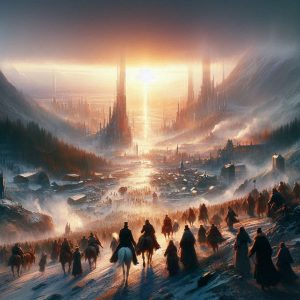
Well, before concluding this episode, with the “great Wells”, I think you can imagine what “volume” of science fiction works I could insert here (just in the time frame between Verne and Wells)!
And, in this sense, does the idea of ”The Birth of True Science Fiction” need any more arguments? If so, let me remind you of some novels that you haven’t yet associated with this effervescent period! So:
- Strange Case of Dr Jekyll and Mr Hyde by Robert Louis Stevenson (1886), an emblematic and influential Gothic novella that explores profound themes related to the duality of human nature, good and evil, repression and liberation, and the unintended consequences of science (although not always strictly classified as science fiction, it contains significant elements that resonate with the Gothic science fiction subgenre and early psycho-horror, Jekyll’s scientific experiment to separate good from evil in human nature by chemical means being a premise that resonates with science fiction, even if it has a strong Gothic component),
- Lumen by Camille Flammarion (philosophical science fiction and cosmic speculation, with elements of astral travel and metaphysical exploration, through an imaginary journey of the protagonist’s soul, who bears the author’s name, Camille, after death, guided by a spiritual entity called Lumen, who reveals to him the secrets of the universe, the history of other worlds, and the nature of time and space) and A Crystal Age by W. H. Hudson (a utopian/dystopian novel with elements of social science fiction and exploration of the future, presenting a distant future in which humanity lives in a peaceful rural society, but strictly hierarchical and controlled by a mysterious elite called the “Masters”, the protagonist, Smith, falling into a deep sleep to wake up in this future world) (1887),
- Looking Backward, 2000-1887 by Edward Bellamy (a highly influential utopian novel that captured the public’s imagination and sparked intense debates about social and economic organization, where the protagonist, Julian West, a wealthy and apolitical young man in 1887 Boston, falls into a hypnotically induced sleep and awakens 113 years later, in the year 2000, to discover a completely transformed American society that has overcome the problems of poverty, inequality, and social conflict by implementing a utopian socialist economic and social system; it was a huge bestseller and had a profound impact on social and political thought in the United States and around the world, inspiring numerous clubs and political movements that supported Bellamy’s ideas, popularizing a specific vision of a utopian socialist society, based on centralized planning, economic equality, and cooperation, influencing numerous subsequent utopian and dystopian works) (1888),
- A Connecticut Yankee in King Arthur’s Court by Mark Twain (a unique combination of alternative historical fiction, social satire, humor, and science fiction elements, particularly time travel and the impact of technology on a primitive society, through the protagonist, Hank Morgan, a pragmatic and inventive American engineer from 19th century Connecticut, who is hit in the head and wakes up in 6th century England, during the reign of King Arthur) and Uranie by Camille Flammarion (philosophical science fiction and cosmic speculation, similar to Flammarion’s previous work, “Lumen”, through a series of dialogues and visions that explore the nature of the universe, the origin of life, the evolution of planets, and the possibility of the existence of other civilizations, with Uranus being one of the muses, the muse of astronomy, who guides the narrator in these cosmic explorations) (1889),
- News from Nowhere by William Morris (a socialist utopian, pastoral, and artistic novel that offers an idyllic vision of a future society, born of a socialist revolution that radically transformed the England of the year 2102, where the protagonist, William Guest, wakes up, being a direct reaction to the brutal industrialization and social inequalities of the 19th century, as well as an alternative to the more centralized and industrialized technological utopias, often interpreted as a direct response, such as that presented in Edward Bellamy’s “Looking Backward”) (1890),
- The Damned Thing by Ambrose Bierce (a defining short story of early cosmic horror that explores themes related to the limited perception of human reality, the existence of invisible and terrifying life forms, and the fragility of our understanding of the world, where the narrative is presented in the form of fragments from the diary of William Harker, a farmer who dies under mysterious and violent circumstances, fragments completed by the coroner’s statement, providing an incomplete and disturbing picture of events, the central element being an entity that cannot be seen by the ordinary human eye, undermining trust in the human senses as the only source of understanding of reality) (1893),
- Omega: The Last Days of the World by Camille Flammarion (an apocalyptic and philosophical science fiction, with elements of cosmic speculation, exploring a distant future in which a comet composed mainly of carbon monoxide threatens to collide with Earth in the 25th century, and, although the collision is avoided, the cosmic event triggers a series of radical physical, psychological and social transformations on the planet, ultimately leading to the end of humanity as we know it, via a new ice age, suggesting an infinite cycle of creation and destruction of universes, even as humanity had developed new senses, electrical, psychic and remote communication capabilities) and A Journey to Other Worlds by John Jacob Astor IV (a utopian/dystopian science fiction, with elements of space adventure and technological speculation, presenting a vision of life in the year 2000, where the United States is a multi-continental superpower, dominated by corporations, with a life enhanced by technology, Europe is presented as being under the control of socialist governments, technology has advanced significantly, etc., the protagonists travel in a spaceship propelled by an anti-gravity force called “apergy” to Jupiter and Saturn; Astor imagines a worldwide telephone network, solar energy, air and space travel, as well as ambitious terraforming projects such as damming the Arctic Ocean or modifying the Earth’s axial tilt) (1894),
- Un Autre Monde by J.-H. Rosny Aîné (“Another world“) (a significant work in the evolution of French and European science fiction, notable for its rich imagination, exploration of speculative scientific concepts and the creation of truly alien extraterrestrial life forms, presenting an expedition to the planet Mars led by the eccentric explorer Paul Anderville who discovers a Martian civilization completely different from the human one, both physically, socially and technologically, the Martians being non-humanoid, being described as crystalline, geometric and mobile life forms, communicating through vibrations and the manipulation of electromagnetic fields, possessing a sophisticated technology, based on the understanding and manipulation of electromagnetic energy, building cities and machines with the help of this energy, etc., an innovative representation for the time) (1895),
- Moxon’s Master by Ambrose Bierce (a short story that explores themes related to early artificial intelligence, the ethics of creation, and the boundary between man and machine, being considered an important precursor to AI-themed science fiction, the story introduces William Moxon, an eccentric and brilliant inventor who creates an intelligent machine, an automaton capable of playing chess, claiming that the machine not only plays chess, but thinks, the story raises fundamental ethical questions about the creation of artificial intelligence and the responsibility of the creator towards his creation) (1899).

From this “chronological” point appears Herbert George Wells, another fundamental author for the development of science fiction, who addressed themes such as alien invasions, world wars, and the consequences of science for human society, his works being characterized by a scientific approach to fiction, combined with a strong social and political dimension.
And his most “remarkable” novels are (from a “Science Fiction” point of view):
- “The Time Machine” (1895): An exploration of the concept of time travel, which became a central theme in science fiction.
- “The Invisible Man” (1897): a novel that follows the story of Griffin, a scientist who discovers a method to make his body invisible, but quickly realizes that invisibility isolates him from society and gives him a dangerous power, causing him to break social ties and disobey laws, transforming himself into a dark and antisocial figure, terrorizing the community in which he hides.
- “The War of the Worlds” (1898): A classic story about a Martian invasion, which inspired numerous film and radio adaptations.
This author has also “benefited” from countless adaptations, starting with the famous 1938 radio adaptation, made by Orson Welles, which caused panic among listeners, as many believed it was a real alien invasion.
And, yes, Welles also wrote other valuable novels, less assimilable to the “Science Fiction” genre, such as The Island of Doctor Moreau (1896) or When the Sleeper Wakes (title changed to The Sleeper Awakes in 1910) (1899)…
Here, at this point in the development of science fiction, a real, palpable question arises: Were these not the golden years of Science Fiction? (especially since I could have implemented dozens of other “science fiction book” references or similar subgenres)…
Or does each step of the evolution of society, science, technology, and access to information by the “masses of readers” give rise to a “golden period” of the new evolutionary “peak”?
So, from this “chronological” point, we can say that we entered the 20th century, whose “beginning” I will address in the next episode, initiating what I “called” “The Seven Years of Science Fiction at Home” by activating the “physical” process of the birth of this genre… Science Fiction… A “baby” that will grow, grow, grow…
Merticaru Dorin Nicolae

